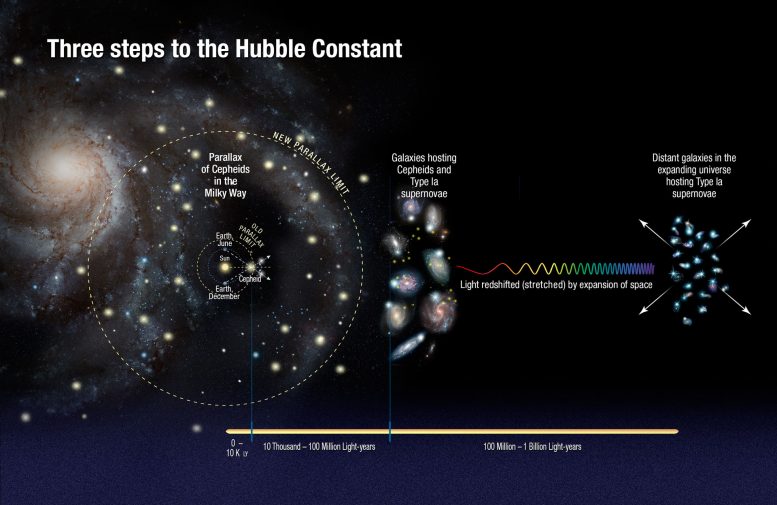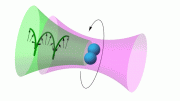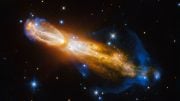
This illustration shows the three steps astronomers used to measure the universe’s expansion rate to an unprecedented accuracy, reducing the total uncertainty to 2.4 percent. Credit: NASA, ESA, A. Feild (STScI), and A. Riess (STScI/JHU)
Using NASA’s Hubble Space Telescope, astronomers reveal that the universe is expanding 5 percent to 9 percent faster than expected.
“This surprising finding may be an important clue to understanding those mysterious parts of the universe that make up 95 percent of everything and don’t emit light, such as dark energy, dark matter, and dark radiation,” said study leader and Nobel Laureate Adam Riess of the Space Telescope Science Institute and Johns Hopkins University, both in Baltimore, Maryland.
The results will appear in an upcoming issue of The Astrophysical Journal.
Riess’ team made the discovery by refining the universe’s current expansion rate to unprecedented accuracy, reducing the uncertainty to only 2.4 percent. The team made the refinements by developing innovative techniques that improved the precision of distance measurements to faraway galaxies.
The team looked for galaxies containing both Cepheid stars and Type Ia supernovae. Cepheid stars pulsate at rates that correspond to their true brightness, which can be compared with their apparent brightness as seen from Earth to accurately determine their distance. Type Ia supernovae, another commonly used cosmic yardstick, are exploding stars that flare with the same brightness and are brilliant enough to be seen from relatively longer distances.
By measuring about 2,400 Cepheid stars in 19 galaxies and comparing the observed brightness of both types of stars, they accurately measured their true brightness and calculated distances to roughly 300 Type Ia supernovae in far-flung galaxies.
The team compared those distances with the expansion of space as measured by the stretching of light from receding galaxies. They used these two values to calculate how fast the universe expands with time, or the Hubble constant.
The improved Hubble constant value 45.5 miles (73.2 kilometers) per second per megaparsec. (A megaparsec equals 3.26 million light-years.) The new value means the distance between cosmic objects will double in another 9.8 billion years.
This refined calibration presents a puzzle, however, because it does not quite match the expansion rate predicted for the universe from its trajectory seen shortly after the Big Bang. Measurements of the afterglow from the Big Bang by NASA’s Wilkinson Microwave Anisotropy Probe (WMAP) and the European Space Agency’s Planck satellite mission yield predictions which are 5 percent and 9 percent smaller for the Hubble constant, respectively.
“If we know the initial amounts of stuff in the universe, such as dark energy and dark matter, and we have the physics correct, then you can go from a measurement at the time shortly after the big bang and use that understanding to predict how fast the universe should be expanding today,” said Riess. “However, if this discrepancy holds up, it appears we may not have the right understanding, and it changes how big the Hubble constant should be today.”
Comparing the universe’s expansion rate with WMAP, Planck, and Hubble is like building a bridge, Riess explained. On the distant shore are the cosmic microwave background observations of the early universe. On the nearby shore are the measurements made by Riess’ team using Hubble.
“You start at two ends, and you expect to meet in the middle if all of your drawings are right and your measurements are right,” Riess said. “But now the ends are not quite meeting in the middle and we want to know why.”
There are a few possible explanations for the universe’s excessive speed. One possibility is that dark energy, already known to be accelerating the universe, maybe shoving galaxies away from each other with even greater — or growing — strength.
Another idea is that the cosmos contained a new subatomic particle in its early history that traveled close to the speed of light. Such speedy particles are collectively referred to as “dark radiation” and include previously known particles like neutrinos. More energy from additional dark radiation could be throwing off the best efforts to predict today’s expansion rate from its post-Big Bang trajectory.
The boost in acceleration could also mean that dark matter possesses some weird, unexpected characteristics. Dark matter is the backbone of the universe upon which galaxies built themselves up into the large-scale structures seen today.
And finally, the speedier universe may be telling astronomers that Einstein’s theory of gravity is incomplete.
“We know so little about the dark parts of the universe, it’s important to measure how they push and pull on space over cosmic history,” said Lucas Macri of Texas A&M University in College Station, a key collaborator on the study.
The Hubble observations were made with Hubble’s sharp-eyed Wide Field Camera 3 (WFC3), and were conducted by the Supernova H0 for the Equation of State (SH0ES) team, which works to refine the accuracy of the Hubble constant to a precision that allows for a better understanding of the universe’s behavior.
The SH0ES team is still using Hubble to reduce the uncertainty in the Hubble constant even more, with a goal to reach an accuracy of 1 percent. Current telescopes such as the European Space Agency’s Gaia satellite, and future telescopes such as the James Webb Space Telescope (JWST), an infrared observatory, and the Wide Field Infrared Survey Telescope (WFIRST), also could help astronomers make better measurements of the expansion rate.
Before Hubble was launched in 1990, the estimates of the Hubble constant varied by a factor of two. In the late 1990s the Hubble Space Telescope Key Project on the Extragalactic Distance Scale refined the value of the Hubble constant to within an error of only 10 percent, accomplishing one of the telescope’s key goals. The SH0ES team has reduced the uncertainty in the Hubble constant value by 76 percent since beginning its quest in 2005.
Reference: “A 2.4% Determination of the Local Value of the Hubble Constant” by Adam G. Riess, Lucas M. Macri, Samantha L. Hoffmann, Dan Scolnic, Stefano Casertano, Alexei V. Filippenko, Brad E. Tucker, Mark J. Reid, David O. Jones, Jeffrey M. Silverman, Ryan Chornock, Peter Challis, Wenlong Yuan, Peter J. Brown and Ryan J. Foley, 21 July 2016, The Astrophysical Journal.
DOI: 10.3847/0004-637X/826/1/56









dark energy expansion of the Universe may be explained by the fact that light especially near the beginning of the BB does not travel directly in a straight line but gets bent around massive objects making it have to travel much further to reach us. After the U was much dense then and there were many primordial black holes in a smaller space.
This is SO MUCH bullsh*t. Feynman was the expert on electromagnetic radiation and he stated unequivocally that QED is NOT a wave theory. All this theorizing on the basis of light as waves is bullsh*t. BULLSH*T. Can I say it more clearly? The emperor has no clothes. All of this theorizing is based on one thing only. There’s a discrepancy between white light measures of distance and red shift measures of distance, and THAT IS ENTIRELY ALL THERE IS in the data. All the rest is mental m*sterbation by cosmologists who have not gotten even a single prediction right despite all their pontification on theory of the origin and fate of the cosmos. Are they so f*cking arrogant that they can’t conceive that maybe, just maybe the interpretation of the red shift is incorrect? Puh-lease. Give me a break!
Chill Nerdrage. The interpretation of the red shift is incorrect!
Data collectors collect data, they don.t create theories. Good data and bad theory, is still bad theory. Hubble did not acccept expansion. He called red shift a “hitherto unknown principle of nature”. Hubble had the integrity to say he did not know what red shift is!
The most popular Theory Telativity, was used to eplain red shift and off we go.
The red shift is a separation measure. Hubble;s Constant is
H = c/R where R is the radius of the Universe and c is the speed of light.
v=Hd = cd/R, the larger the separation d, the larger the v.
The Hubble constant is H=c/R= c/cT= 1/T , the age is T=R/c.
There is no Dark Energy driving expansion. There is vector Energy cP, tht prevents gravitional collapse. This cP is the missing component of the proper theory of Physics. The Proper Physics is Quaternion Cosmology and the Gravitational Energy is;
W = VP = [c,V][0,P] = [-vp,cP] = [-mGM/r,cP]
Note the scalar velocity is the speed of light c. The Momentum is a vector. [,mV] = [,P].
This is the correct Theory of Gravity.cP is the energy that is called “Dark Energy/Matter” in the current incorrect Theories!
Chill, it only takes 100 years to correct the interpretation and correct the Theories.
PS Dark Matter, cP=ezI; mV=euI; V=(e/m)uI= 176G 1.25u I = 220kIm/s!
I is the current from the rotation of chatfed suns in the galaxy. The electron flow into the galaxy creates the fast rotation,
eVxBsinX=vP/r thus P=eBr sinX =euIsinX = euI at angle 90 degree when C is into plane and B is perpendicular.
Great Job done!
I don’t think it is expending. It would have to be expending into something yet there is nothing to expend into so the term is false.
Hubble Reveals Kim Kardashian’s Booty Is Expanding Faster Than Expected
I look at this “rapid expansion” as very good news… especially if it really does turn out that we all exist within a hologram or simulation…
We’re getting more disk space!!! WooHoo!!!
STFU, please.
Can someone please explain to me how dark matter is causing galaxies to expand away from each other but that same dark matter is not causing objects within a given galaxy to expand away from each other?
Sean, you’re confusing dark matter (about which we know very little) with dark energy (about which we know even less). I hope everything is now clear.
No surprise here since the Univers reflects the rapid expansion of Humanity and likely other celestial cultures.
Can someone explain why dark energy/matter cannot be explained by the “light” waves or pulses or whatever that has been emitted since the beginning of the universe? “Light” is matter transformed and “generally” travels in straight lines. Just at the big bang, the light/radiations must have been immense and its attraction back to the source (and vice-versa) must have been immense and helped pull the big bang apart. As that energy and additional “light” energy emitted from the remnants of the big bang had a pulling effect, it helped pull the matter behind it faster and faster from the concentric remnants of the big bang. Just as light cannot be seen directly until it hits (pushes) something, it does have energy being absorbed by what it strikes. Light that goes away from the visible universe without interacting with other mass still exerts an extremely minute pull backwards. Multiplied by an unimaginable amount of such “radiation” from the universe could help explain the increase in speed of the separation of matter from the center of the big bang. Light/radiation from the center of the big bang that hits matter that preceded it outwards helps “push” that matter further away. Billions of years of absorbing more radiation from the center of the big bang than is received from other light sources (galaxies, etc.) would have the net effect of pushing the matter away from the center (adding to the momentum left over from the initial creation).
I realize that I am probably way out of my league in posing this hypothesis but I would appreciate someone explaining why I am grossly wrong in my thinking.
I like the way you see the Big Picture, John! Your sentence “As that energy and additional “light” energy emitted from the remnants of the big bang had a pulling effect, it helped pull the matter behind it faster and faster from the concentric remnants of the big bang.” That brought back an old memory …. Popeye had to get across a ravine to save Olyv from Bluto. He tied a rope round a boulder, and the other end round his waist. Then he hurled the boulder across the ravine. It worked fine in the cartoon world, but I could see Newton in the background, shaking his head.
I have another conundrum that I am unable to reconcile. We are supposedly seeing light emitted from close to the time of the big bang – all these postings talk about looking back in time as to “billions of years into the past”. The conundrum is the question of “how did we get so far away in the universe that “light” from the big bang is just catching up with us????? If that isn’t enough of a question, a related question that relates more to dark matter is: If the big bang was a point source, then energy and matter flowed out in a spherical shape. If we can see close to the big bang, what about the other sides of the big bang that are, arguably, out there and heading away from us. We would only theoretically see light from sources that were within the cone defined by 13.5 billion years from us. The matter outside that limit would account for more than half of the mass of the universe.
So, if we believe that our World has started sometimes ago we are still in the position to decide which hypothesis, Lemaître’s or Gamow’s was closer to reality. There is an opinion that the problems in the standard cosmology could be solved by adjusting of details. Our suggestion is that we have to go back to the conceptions and use the observations accumulated since.
I think everyone is wrong…I think we have already expanded and are rushing back in….
Our Universe
Copyright 2020 Wardell Lindsay
The Universe is expanding to it reaches it the Boundary. The velocity will be c at the Boundary. The interim expansion speed is roughly 150Mm/s at half size of Universe. The Universe is 3E26m Radius.
Mass of Universe =405E51kg
Energy Universe =3645E67 J